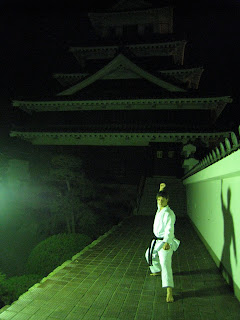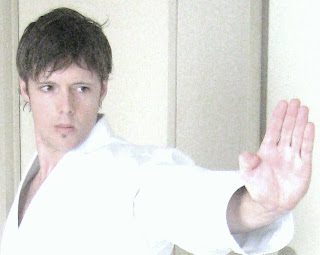 I thought I’d provide an overview of the final group lesson of 2008. For those of you who haven’t lived and trained here in Japan, hopefully it will provide some interesting reading, and perhaps some ideas, for your own karate practice.
I thought I’d provide an overview of the final group lesson of 2008. For those of you who haven’t lived and trained here in Japan, hopefully it will provide some interesting reading, and perhaps some ideas, for your own karate practice.___________
Kizami-zuki kara gyaku-zuki soshite... After warming up and the standard repetitions of stationary chudan gyaku-zuki, and kizami-zuki kara gyaku-zuki, Tachibana Shihan had us once again fire out kizami-zuki kara gyaku-zuki. However, this time, we continued on with a 180 degree turning gyaku-zuki. From this position, keeping the rear foot fixed, we had to stretch our stances for a very long kizami-zuki. To recover, contract the lead leg back into a ‘normal zenkutsu-dachi shomen’ simultaneously punching gyaku-zuki. From this position, the drill simply restarted.
Jiyu-kumite specific variation: After a brief ‘rehydration period’ we once again executed the drill, but this time from jiyu-kumite no kamae. The other major difference was to train the support/driving-leg in a ‘gymnastically superior’ fashion. This was to ensure maximum power is generated from the back leg and that the body weight is fully committed. Essentially this was achieved by taking three big ‘support leg hops’ for distance (whilst deeply compressing the springing leg) then exploding forward with a large scale gyaku-zuki.
Sen no sen (taking the initiative earlier): After ample practice we moved onto partner applications utilising the three hops as a means to train attacks with tobi-konde gyaku-zuki. Focus was twofold: Firstly, the connection between the support leg and the fist going ‘through the opponent’. And secondly, attacking from a very long distance. Initially we practiced moving directly in ‘on the line’, and later, going past the opponent whilst hitting. When ‘going past’ we were required to get our lead leg alongside the opponent’s rear leg. In both cases, this was supplemented by Asai-ryuha fundamental methods of ‘jamming’ and ‘freezing’ opponents with tate-shuto, seiryuto, and/or kake uke. Variations included: (a) Opening and unbalancing with kake uke namely to the inside and outside of the elbow joint; (b & c) Controlling the opponent by freezing/jamming either the front or rear shoulder joints with tate-shuto and seiryuto.
Go no sen (taking the initiative later): Shihan then demonstrated the above three karada no buki to neutralize incoming attacks with kizami-zuki and gyaku-zuki. He also briefly reviewed the basic ‘l
 eg blocks’ to freeze the opponent’s stance, and also deflect/jam kicks (focusing on the hip, knee and ankle joints). The leg blocks Tachibana Shihan brilliantly demonstrated included uchi and soto ashikubi kake uke, sokuto and sokutei osae uke, amongst others.
eg blocks’ to freeze the opponent’s stance, and also deflect/jam kicks (focusing on the hip, knee and ankle joints). The leg blocks Tachibana Shihan brilliantly demonstrated included uchi and soto ashikubi kake uke, sokuto and sokutei osae uke, amongst others.Ashi-barai: Next it was on to inside and outside leg sweeps by following the same principles vigorously practiced in the previous drill. We initiated our attack with the same gyaku-zuki. From here we made three rearward ‘support leg hops’ coordinated with mae ashi-barai to sweep the opponent. Once again, like the initial gyaku-zuki, the key was not focusing the ‘action limb’, but rather, the commitment of full-body weight, via the support leg. The hops truly tested if you were doing this correctly, and as stated before, were gymnastically excellent for the training the supporting leg. In the case of the first ‘hop’ not downing your partner, Tachibana Shihan told us to hop again, and again, until the opponent is floored.
Kiba dachi de ashi barai: We practiced the classic inside and outside leg sweeps with kiba-dachi. This built up to ducking under a kizami-zuki then downing the opponent. In addition to ducking and entering, we also practiced rapidly switching the legs then pivoting in for the sweep. Kaiten-shinagara was not covered today.
Kata and kihon oyo kumite: To complete the lesson we executed Junro-shodan three times, Junro-nidan three times and Junro-sandan two times. After completing each of them we did the corresponding kihon oyo kumite. Tachibana Shihan emphasised that “The Junro kata were developed by Asai Shuseki-Shihan specifically for kumite”. So in addition to going through the standard applications, and some variations, each person had to demonstrate their own interpretation for different sequences within the kata. Overall a great way to end an excellent karate training session... Really speaking, more of a 'lesson' than merely a 'work out'.
________
To conclude I’d like to say that I deeply appreciate the excellent tuition I’ve received this year from Tachibana Shihan (JKS 8th Dan). Domo arigato gozaimasu Shihan. Likewise, I’d like to thank the members of the Japan Karate Shotorenmei Oita Sohonbu for their camaraderie. I look forward to returning to group training with you all on January 10th.
OSU, André
 ________
________© André Bertel, Japan 2008



+-+%E3%82%B3%E3%83%94%E3%83%BC.JPG)

.jpg)
.jpg)
































.JPG)





.JPG)
.JPG)